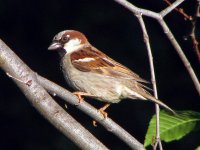In a recent trip to Boston I noticed that the house sparrows seemed significantly bigger than the variety around my house (in ireland) and that their plumabe seemed distinctly warmer. After 100 years of seperation they are undoubtedly starting to split and presumably adapt to local conditions but has anybody ever assessed the degree of genetic seperation? Also, if they had not colonised the intense urban inner city areas in the US, what species would have taken this niche? None?
Attachments
Last edited:






